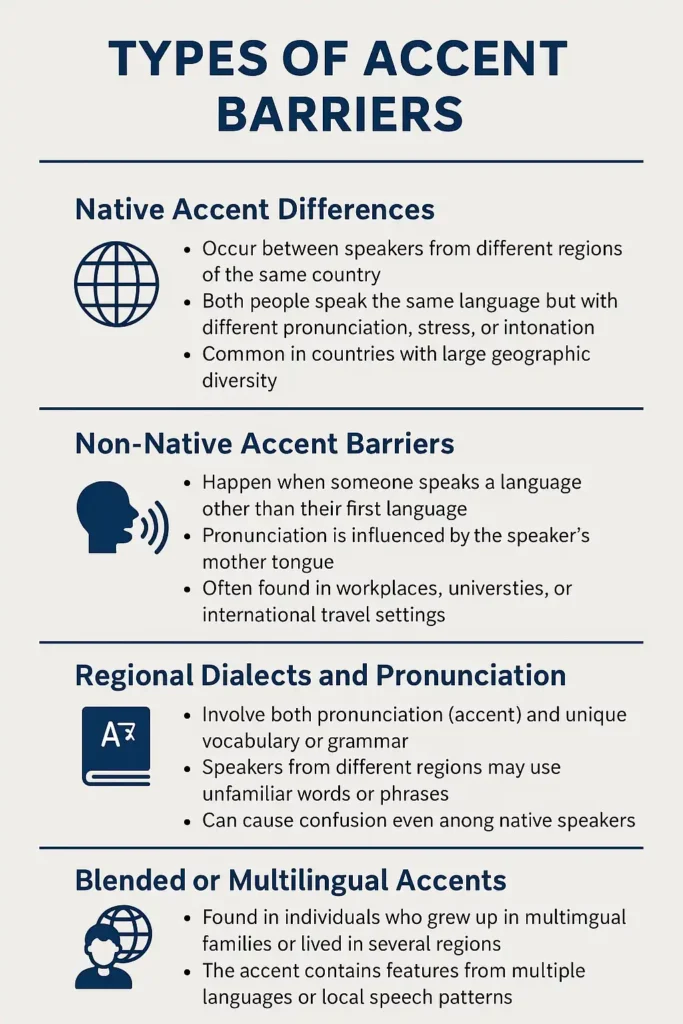Accent Barriers to Communication
Ever been part of a conversation where you just couldn’t catch what the other person was saying because of their accent? It’s more common than most people think. Accent barriers to communication show up in classrooms, offices, call centers, and even friendly get-togethers.
The problem goes beyond simple pronunciation differences—it can create confusion, frustration, and even embarrassment for everyone involved. When accents lead to misunderstandings, it can hold back teamwork, slow learning, and cause people to feel isolated. Why does this happen, and what can anyone do to communicate more clearly, no matter which accent is in play? That’s what this guide is all about.
What Are Accent Barriers in Communication?
Accent barriers happen when a speaker’s pronunciation or way of speaking makes it hard for others to understand. These barriers can show up in any language. For example, a British manager might be tough to follow for a new American employee, or a French speaker in Canada could face challenges in a Toronto boardroom. These differences are part of what makes human communication interesting, but they also introduce obstacles.
Accents reflect culture, geography, and upbringing. Every accent has its own patterns—like rhythm, stress, and melody—that listeners get used to over time. When we hear a new accent, our brains need extra effort to process the sounds and connect them to familiar words. This extra effort is known as cognitive load. If a conversation requires too much of it, listeners may feel tired or start missing details.
Accent barriers aren’t only about native and non-native speakers. Sometimes, people from different regions in the same country struggle to understand each other, like someone from rural Texas talking with someone from New York City. In multicultural teams and global companies, accent differences are almost guaranteed.
Types of Accent Barriers

Native Accent Differences
People who speak the same language but come from different regions often have unique ways of pronouncing words. For example, someone from the southern United States might sound very different from a person raised in New England. These regional accent differences can sometimes lead to misunderstandings, even when everyone is fluent in the same language.
Non-Native Accent Barriers
When someone learns a new language as an adult, their first language often influences how they pronounce words in the new one. These are called non-native accents. Non-native speakers may have trouble with certain sounds or stress patterns, making their speech harder for native speakers to follow. This type of accent barrier is common in global companies, universities, and multicultural teams.
Regional Dialects and Pronunciation
Dialects go beyond accent. They also involve unique vocabulary, grammar, and expressions that can further complicate understanding. Even within the same country, people from different cities or areas may use words or phrases unfamiliar to outsiders. This creates dialect barriers, which combine accent and language differences.
Blended or Multilingual Accents
Some individuals grow up speaking more than one language or living in several regions. Their accent may blend features from different languages or places, leading to a hybrid accent. While this can make their speech unique, it might also confuse listeners who are used to a single, familiar accent.
Why Do Accent Barriers Cause Problems?
Accent barriers do more than slow down conversations. They affect emotions, confidence, and opportunities. When you can’t understand someone, you may ask them to repeat themselves, which can be awkward or even embarrassing. Over time, this experience may lower confidence or discourage people from speaking up, especially in group settings.
Research published by the University of Alberta found that comprehension accuracy drops by up to 30% when listeners are exposed to a new or unfamiliar accent at work. That means important details, instructions, or ideas might not get across, and teams can lose time and motivation as a result.
Bias can also creep in. Some studies show that people judge speakers with “strong” or unfamiliar accents as less capable—even if their skills are top-notch. This bias, sometimes called linguicism, is a form of discrimination based on language or accent and can impact hiring, promotions, and workplace trust.
Cognitive Load and Listening Fatigue
One of the biggest challenges with accent barriers is the mental strain it puts on listeners. When faced with unfamiliar pronunciation, the brain must work harder to process sounds, leading to what experts call listening fatigue. Over time, this extra effort can drain energy and focus, especially during long meetings or in fast-paced environments.
Gass and Varonis, in their landmark study, found that listeners get better at understanding new accents with more exposure, but the adjustment isn’t instant. People working in international teams often notice that it takes a few weeks or months before they become comfortable with each other’s speech patterns.
Accent Barriers in the Workplace
Workplaces today are more global and diverse than ever before. As a result, accent barriers are a daily reality in many offices and on virtual calls. When colleagues have trouble understanding each other, collaboration slows, projects can suffer, and morale dips.
Accent-based misunderstandings might result in wrong instructions, missed deadlines, or costly mistakes. For example, customer service teams often face complaints or lost business if clients struggle to understand representatives over the phone.
Bias is another problem. Some managers may favor employees with accents similar to their own, whether they realize it or not. According to the Equal Employment Opportunity Commission (EEOC), accent discrimination is illegal in many countries, including the U.S., unless the accent truly affects job performance.
To create fairer environments, many organizations now offer training in accent awareness, cultural competence, and inclusive communication.
Accent Barriers in Education
Accent barriers show up in classrooms too. Teachers with strong regional or foreign accents might find that students miss key points, especially in large or noisy classes. Similarly, students with “different” accents may hesitate to participate, fearing ridicule or misunderstanding.
Universities and schools are increasingly offering accent comprehension workshops, peer mentoring, and technology aids like real-time captions to help all learners keep up. This not only improves understanding but also builds a culture where everyone feels valued.
Sociolinguistics and Accent Bias
Why do accents trigger such strong reactions? Sociolinguistics—the study of how language works in society—shows that accents carry powerful social meaning. People make instant judgments about a speaker’s background, education, or ability based only on how they sound.
This can lead to accent bias, which shows up in job interviews, classrooms, and even healthcare settings. Timmis (2022) notes that many hiring managers unconsciously favor candidates whose accents match their own. Such biases are not just unfair—they can limit diversity and block talented people from reaching their potential.
Legal and Ethical Issues Around Accent Discrimination
Laws in many countries recognize that accent discrimination is a real issue. The EEOC makes it clear that, unless an accent directly affects someone’s ability to do their job, it shouldn’t factor into hiring or promotion decisions. In the UK and parts of Canada, similar laws exist to protect against unfair treatment.
Workplaces can address these issues by updating HR policies, providing regular training, and creating safe spaces for feedback. Transparency and accountability help ensure everyone gets a fair shot.
Accent Barriers and Technology
Technology is a double-edged sword when it comes to accents. On one hand, digital tools such as live captions, translation apps, and speech recognition software (like Google Assistant) can help people bridge accent barriers. On the other hand, these same tools sometimes struggle with non-standard or strong regional accents, leading to mistakes or misunderstandings.
A study published in the Proceedings of the National Academy of Sciences found that voice assistants are less accurate when interpreting non-native or regional accents, sometimes resulting in real frustration for users.
Modern organizations can improve accessibility by regularly testing tech tools with a variety of voices and making sure help is always available for those who need it.
How Accent Barriers Impact Healthcare and Critical Services
In healthcare, accent barriers can have serious consequences. Miscommunication between patients and healthcare providers can lead to incorrect diagnoses or medication errors. For example, hospitals in the UK and the U.S. have reported cases where misunderstandings due to accent differences resulted in delays or confusion during patient care.
Medical centers and emergency services increasingly use interpreter services, real-time transcription, and training for staff to minimize the risks of accent barriers. Clear communication in these settings isn’t just helpful—it’s essential for safety.
Accent Barriers in Customer Service and Call Centers
Anyone who has called a customer service line knows how tricky accent barriers can be. Whether you’re the customer or the representative, clarity is crucial. If someone can’t understand the instructions, frustration builds, and the company risks losing business.
Call centers now use training programs, accent modification support, and technology such as AI-powered transcription to improve understanding. These changes help both customers and employees feel heard.
Accent Barriers in Global Business and Cross-Cultural Communication
In international business, accent barriers are especially common. Teams spread across countries and time zones must work together despite differences in language and pronunciation. Successful global companies train employees in cross-cultural communication, focusing on listening skills, patience, and respect for all voices.
Language learning and accent comprehension become business skills—just as important as technical knowledge. Regular exposure to different speech patterns builds confidence and speeds up understanding, making global work smoother for everyone.
Accent Modification
Some people wonder if they should try to change their accent to be better understood. Speech-language pathologists offer accent modification sessions, but the goal is usually clarity—not “erasing” someone’s identity. Techniques include slowing down, enunciating clearly, and practicing common stress patterns in the target language.
Many experts argue that no one should feel pressured to hide their accent. Instead, the focus should be on making sure everyone can communicate and be understood. Organizations and schools can help by supporting accent diversity, not just accent reduction.
Overcoming Accent Barriers
Accent barriers can be frustrating, but there are many practical ways to reduce misunderstandings. Here are some proven strategies:
- Practice active listening: Summarize what you’ve heard, ask clarifying questions, and encourage others to do the same.
- Speak at a steady pace: Avoid rushing, and pause to let your message sink in.
- Use visual aids: Slides, written notes, or even hand gestures can make your point clearer.
- Confirm understanding: After important points, ask if everything makes sense or offer a quick recap.
- Get regular exposure: Watch movies, listen to podcasts, or join online groups with diverse speakers. This helps your ear adjust to different speech patterns.
- Use tech tools: Try real-time captioning, voice recorders, or transcription services in meetings.
- Encourage training: Suggest workshops on accent awareness or cross-cultural communication in your workplace or school.
Tools and Resources to Tackle Accent Barriers
A growing number of resources are available to help people handle accent differences more effectively:
- ELSA Speak: An app that helps users practice pronunciation and improve clarity.
- Speechling: Offers free accent comprehension and pronunciation coaching, with audio samples from native speakers.
- Forvo: A massive database where you can hear native speakers pronounce words from hundreds of languages and regions.
- Interpreter services: Many workplaces, schools, and healthcare centers now provide on-demand interpreters or real-time translation tools.
The Role of Organizations in Building Inclusive Communication
Forward-thinking organizations don’t just tolerate accent differences—they support them. That means investing in training, updating hiring practices to prevent bias, and encouraging all team members to speak up. When companies create a culture of respect, productivity and trust grow.
Including accent awareness in diversity, equity, and inclusion (DEI) initiatives ensures that no one is left out because of the way they speak. Employees feel comfortable sharing ideas, and the entire team benefits from a wider range of perspectives.
The Future of Accent Barriers
Accent barriers aren’t going away, especially as the world gets more connected. However, people and organizations are finding better ways to address these challenges. AI tools will keep improving, cultural competence will become a bigger part of training, and more workplaces will value linguistic diversity.
Instead of seeing accents as a problem, there’s a shift toward appreciating the rich backgrounds and perspectives they represent. The more people interact with a variety of accents, the easier it gets to understand, connect, and succeed together.
Conclusion
Accent barriers to communication can disrupt conversations, but they also offer a chance to build stronger, more inclusive relationships. By recognizing why these barriers exist and using practical solutions, anyone can communicate more clearly—no matter where they’re from or how they sound. Whether you’re an employee, student, teacher, or leader, supporting accent diversity leads to a more open, productive environment. If you want to learn more about overcoming all kinds of barriers to communication, check out our full guide here.
Clear communication is possible when everyone takes small steps to understand and include each other. Embrace every accent as a part of what makes your community unique. Together, we can break down barriers and help every voice be heard.
FAQs
Q1: Can accent barriers affect job opportunities?
Absolutely. Studies have found that some employers unconsciously judge applicants based on accents, which is why fair hiring policies are so important. The EEOC in the U.S. protects against this kind of discrimination.
Q2: Is it possible to improve understanding of different accents?
Yes. With regular exposure, listening practice, and communication training, people get better at understanding a wide range of accents.
Q3: Should people try to change their accent to fit in?
No one should feel forced to lose their accent. Focus on clarity and confidence. If you want to improve pronunciation for clearer communication, speech-language pathologists can help.
Q4: What technology can help with accent barriers?
Apps like ELSA Speak, Speechling, and AI-powered transcription tools are very helpful. Real-time captions and interpreter services are also widely used in business and healthcare.
Q5: How can organizations support accent diversity?
By offering training, using fair hiring practices, and promoting an inclusive culture where everyone’s voice matters.






